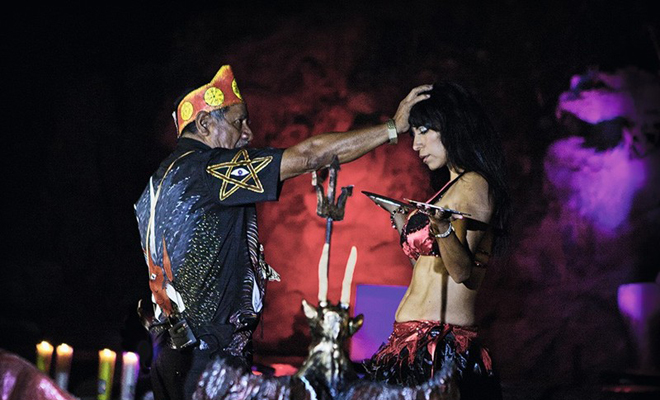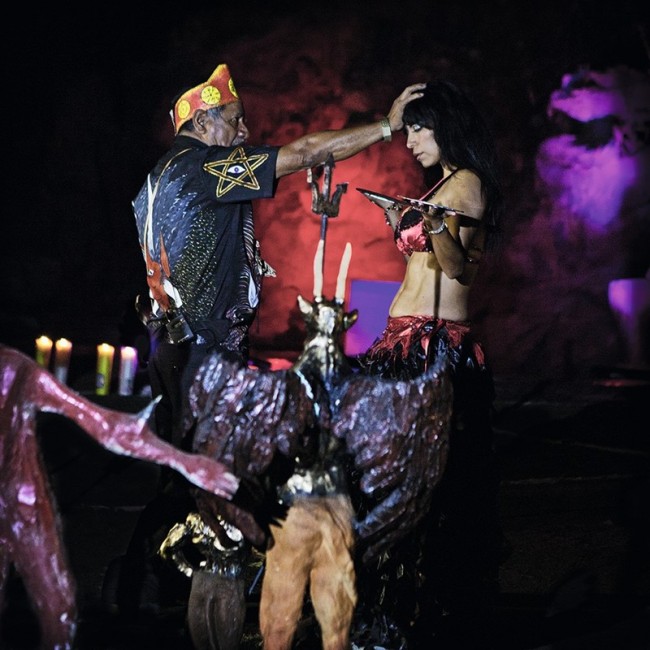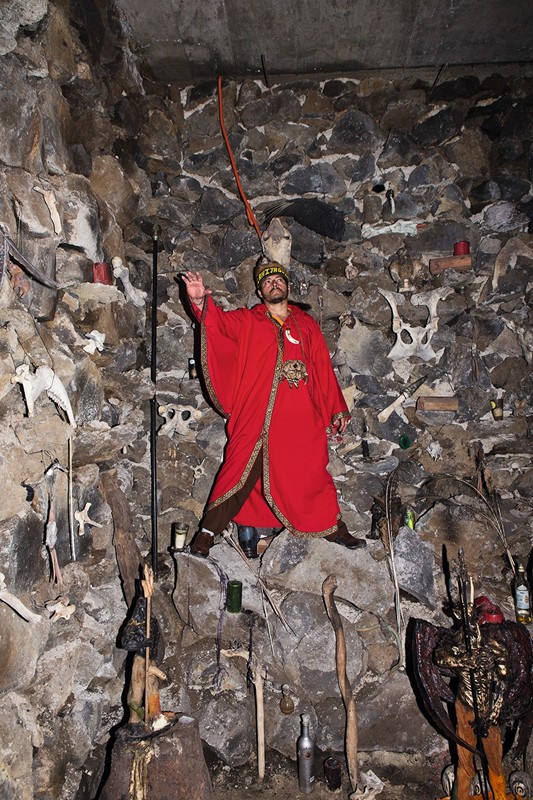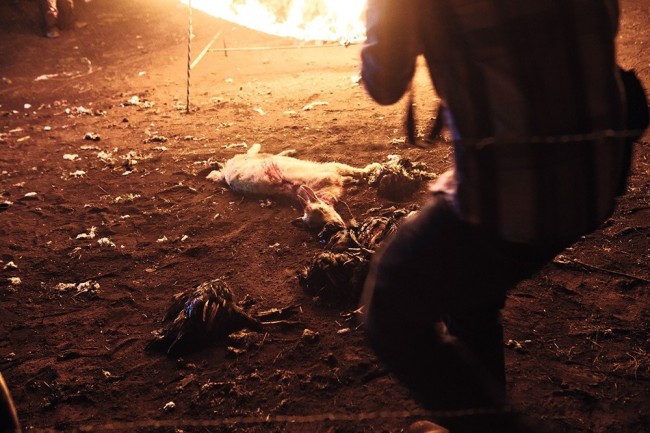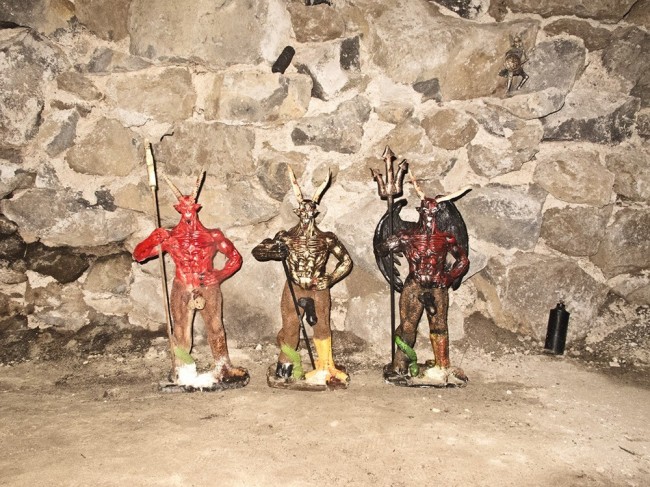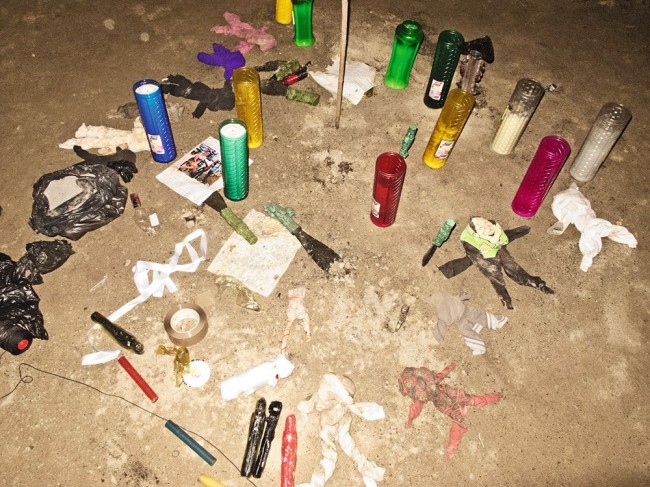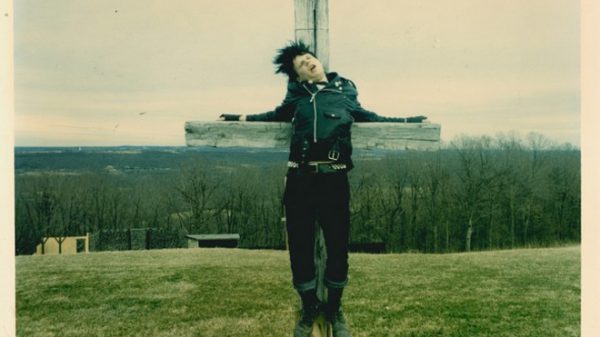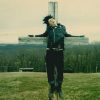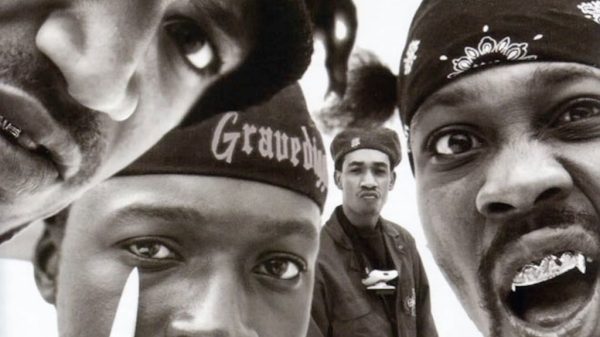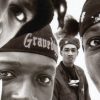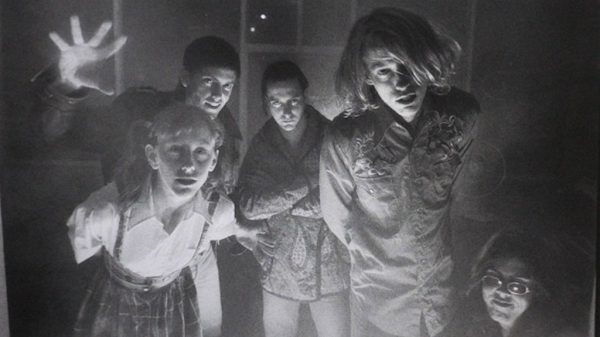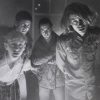via Dazed Digital
Text & Photos by Tony Farfalla
The heat from the enormous burning pentagram is nearly unbearable as I move closer to the flames. Beyond the fire, I see the faces of brujos (witch doctors) with their arms in the air. Their faces are smeared with blood and cheap tequila, their dark robes embroidered with stars and inverted crosses. A half-naked woman is dancing beside them in a seductive red dress, her hips bouncing to the rhythm of a large drum played by a muscular man in a Mayan headdress. In front of my feet rest the bodies of a dead goat and several black chickens. This is a black mass, and these are the Satanists of Catemaco, Mexico.
This small town, located on the eastern gulf coast among rolling hills of vast jungle and volcanoes, lies next to a massive lake. But there’s more to the place than the lush valleys and pristine waterfront – the brujos of Catemaco are well-known to magic seekers as the most feared and powerful shamans in Mexico. They are also the most marketable.
Tony Farfalla
I first meet Reyes Alvarez Montes, the chief brujo of Catemaco, a few days earlier, when he hands me a business card that features a photo of him in front of a burning pentagram, with overlaid images of beautiful women and demonic faces. His phone number and email are at the bottom. He’s in his late 60s and has lived in the town his entire life. “This place is a portal between earth and the underworld,” he says. “Throughout history, darkness has come from the caves in our hills, and I invoke it.”
The next morning I arrive at the home of his student Enrique, who’s occupied with performing a cleansing ceremony for a man who’s been cursed. When it’s finished, Enrique greets me with a smile and offers to show me his “office”. We walk to a barren cement structure a short distance away and climb down a steep staircase into a basement. I can barely make out the shape of an animal skull on a wall in front of me until Enrique’s five-year-old son flips on the light and I see that I’m standing in a cave designed for satanic worship. Bones line the walls, black candles fill each corner, and statues of various demons sit on the dirt floor. A small table in front of me is adorned with bottles of alcohol, various knives, photographs, and handwritten letters from patrons requesting assistance. This is where Enrique consults with the dark spirits, working with them to fulfill the desires of his clients. “There are three creatures I work with,” he says. “Lucifer, Satan, and the devil.” He points to three statues of horned beings. “They are all different, and I am friends with each of them.”
Tony Farfalla
Although the scene may look like the set of a schlocky B-movie horror flick, there is a very distinct energy in this room. A rather uncomfortable heaviness pulls at me as I consider the various rituals that occur here, and the sincere attempt to manifest dark spirits into reality. I can see the forthright devotion in Enrique’s eyes; he’s clearly a faithful believer in dark magic.
One of the more popular brujos in the area, Enrique has been studying under Montes for six years. Younger and more ambitious than his teacher, he has created a more marketable approach to brujería (witchcraft) that includes a website and a Facebook page. He performs rituals with both white and black magic depending on the situation, and assists with problems to do with everything from finance and love to death and healing. His practice is a blend of ritual and symbolism from many cultures, and his most powerful allies are Catholic conceptions of the evil lord.
Later, Montes invites me to attend a healing ceremony at his office on the edge of town. I find the old brujo sitting in the corner of a small room in a white robe with gold edging, trimming flowers. A young woman with an incurable stomach disease is here in the hope that he can draw the sickness out and save her life. “Today I will use white magic to help this woman,” he tells me with confidence.
The woman lays still on the ground, her eyes closed, her breath heavy. Montes begins to shout at something that is not visible in the room. His words grow louder as he prays for assistance, moving his hands over her body, his eyes glazed over. An associate holds a bell by the woman’s belly and rings it sharply, before throwing white and yellow flower petals over her body. The woman begins to shake and moan. “With your power take this evil out of her!” the old brujo shouts, throwing his hands in the air. She begins to calm, and when she is still, Montes tells her she may leave. The cleansing is done. The woman has apparently been healed.
That night I can hardly sleep as my mind digests the information from the past few days. I awake in the middle of the night and see a figure in the corner. I feel the presence of something in the room, but when I move closer, there is nothing. The following day I share this story with my friend, who was also asleep in the room. He says he felt the same thing. We agree to leave the following night after a final ceremony is performed.
The next time I see Montes he’s leading the black mass, which takes place on Enrique’s property. I am invited along with a small group of initiates, and we gather at midnight to watch as the brujos open the portal to the underworld.
Seven brujos gather inside a giant pentagram drawn on the earth to initiate a few new members. Fires burn in the cliffs behind them and copal incense fills the air with smoke. Montes wears a wireless microphone that blasts his charged words through a single crackling loudspeaker. A small group of drummers dressed in traditional Mayan wardrobe beat methodically on their drums as three women in red dresses dance around the elders. At each point of the pentagram, there is a black chicken with its wing nailed to the earth. It flaps frantically on the ground, kicking up dust. To the side, I hear the soft cries of a small goat. The heaviness I felt in Enrique’s cave creeps up on me again.
It begins to rain as they pour whisky and rum over satanic statues. Each initiate is brought in front of the statues and asked to receive the dark lords into their hearts. Then Enrique removes the heads of each chicken and sprays the warm blood onto the faces of the initiates and the statues. Montes retrieves the goat, and as the drums grow louder, the animal is placed over the shoulders of a large man who sits still on a chair. The goat’s cries end when Montes draws a knife across its throat. The blood pours over the seated man and is painted on the faces of the crowd.
In the end, a giant standing pentagram is set on fire. “We will now close the gates to hell,” Montes shouts. He throws the bodies of the sacrificed animals through the flaming structure. The goat lands near my feet. The ceremony is over.
Tony Farfalla
Everyone lines up to take pictures in front of the burning pentagram. They pose with the brujos, smiles spread across bloodstained faces, and hold their arms in the air and laugh.
I depart from this place with a shaken understanding of Catemaco and the infamous brujos. Montes and Enrique practice satanic praise but also call upon God and Jesus for assistance. They heal and condemn, working with the light and the dark. There must be an appreciation of both. But in the end, they belong to the devil; they have made a deal with darkness. “I know that I am doing evil things,” Montes tells me, “but I was born into this work. The devil is inside me.”
